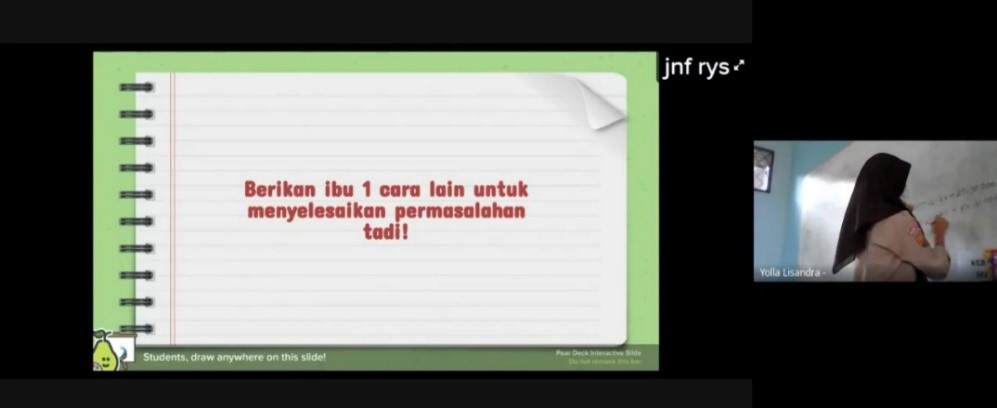Students’ problem-solving ability in hybrid learning using problem-based learning model: a case study
Keywords:
PROBLEM-SOLVING ABILITY, HYBRID LEARNING, PROBLEM-BASED LEARNING MODEL, CASE STUDYAbstract
This study aimed to describe the process of learning mathematics in hybrid learning using a problem-based learning model. Furthermore, investigate the performance of students' problem-solving abilities in hybrid learning using problem-based learning. This case study research was conducted in one of the secondary schools in Bogor, Indonesia with a total of 20 students (13-15 years old) and a sample of six students who were selected based on convenience sampling. Data were collected through participant observation and written test. Researchers carry out problem-based learning on the material of a two-variable system of linear equations. The results showed that the hybrid learning process went smoothly. Students were enthusiastic about new media of learning. However, researchers found differences in the strategies used by students at home and school. Students' problem-solving ability to understand the problem is in a good category; devising a plan has a good enough category; carrying out a plan is not good enough; looking back is still in the very poor category.
References
Berinderjeet, K., Yeap, B. H., & Kapur, M. (2009) (2009). Mathematical problem solving: Yearbook 2009. Singapore: World Scientific Publishing.
Boud & Felleti (1998). The challenge of problem-based learning. Kogan Page. Sydney, Australia.
Cohen, L., Manion, L., & Morrison, K. (2017). Research methods in education. Routledge.
Harianda, B., & Diana, L. (2021). Analysis of mathematical problem-solving ability for VII class students of SMP during the COVID-19 pandemic. Journal of Research on Mathematics Instruction, 2(2), 1–14. https://doi.org/10.33578/jrmi.v2i2.51
Husnidar, et al. (2014). Penerapan model pembelajaran berbasis masalah untuk meningkatkan kemampuan berpikir kritis dan disposisi matematis siswa. Jurnal Didaktik Matematika, 1(1), 71-82. https://jurnal.usk.ac.id/DM/article/view/1288
Jacinto, H. (2023). Engaging Students in Mathematical Problem Solving with Technology during a Pandemic: The Case of the Tecn@ Mat Club. Education Sciences, 13(3), 271. https://doi.org/10.3390/educsci13030271
NCTM. (2000). Principles and Standards for School Mathematics. Reston Virginia: NCTM
Nurkaeti, N. (2018). Polya’s strategy: an analysis of mathematical problem solving difficulty in 5Th grade elementary school. EduHumaniora: Jurnal Pendidikan Dasar, 10(2), 140-147. https://doi.org/10.17509/eh.v10i2.10868
Polya G. (1973). How to solve it, Second Edition. California: Stanford University.
Pratiwi, Y. K., & Masduki, M. (2023, June). Analysis of students’ mathematical problem-solving ability using Google Classroom during the CoViD-19 pandemic. In AIP Conference Proceedings (Vol. 2727, No. 1). AIP Publishing.
Saygılı, S. (2017). Examining the problem-solving skills and the strategies used by high school students in solving non-routine problems. E-International Journal of Educational Research, 8(2), 91-114. http://www.e-ijer.com/tr/download/article-file/338828

Published
How to Cite
Issue
Section
Copyright (c) 2023 Yolla Lisandra, Desyarti Safarini TLS

This work is licensed under a Creative Commons Attribution-ShareAlike 4.0 International License.




